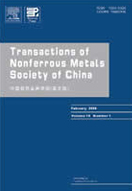INTERFACIAL REACTION BEHAVIOUR AND JOINT STRENGTH OF TiCp/Si3N4COMPOSITE
BONDED WITH Al FOIL①
BONDED WITH Al FOIL①
(1 Department of Materials Science&Engineering,
Jiangsu University of Science&Technology, Zhengjiang212013, P. R. China
2 Department of Materials Science&Engineering,
Zhejiang University, Hangzhou 310027, P. R. China)
Jiangsu University of Science&Technology, Zhengjiang212013, P. R. China
2 Department of Materials Science&Engineering,
Zhejiang University, Hangzhou 310027, P. R. China)
Abstract: The joints of Si3N4composite bonded with Al foil were treated by metal joint becoming ceramics. Reaction behavior of the interface between Si3N4and Al in joining of TiCp/Si3N4composite with Al foil was studied by means of SEM, EPMA, XRD and AES. The results show that Si, N and O diffuse from the TiCp/Si3N4composite into Al liquid phase zone to produce AlN, Al2O3·SiO2at 1273K, while at 1173K, only alumina is detected at interface. The thermodynamic and thermal stress analyses at the interface show that the interfacial reactions of interface are influenced not only by bonding temperature and the oxide formed at the faying surface before bonding, but also by the atmosphere of the furnace containing graphite heating ele-
ments. The effect of bonding temperature on joint strength depends on the effect of joining temperature on reaction products at the interface. The room and high temperature strengths are enhanced after metal joints have become ceramic.
ments. The effect of bonding temperature on joint strength depends on the effect of joining temperature on reaction products at the interface. The room and high temperature strengths are enhanced after metal joints have become ceramic.
Key words: Si3N4 ceramic composite Al foil interfacial reaction metal joint ceramic joint

